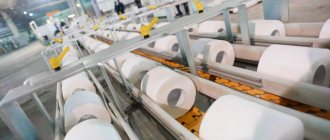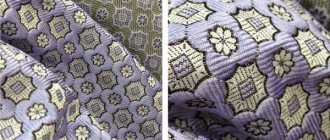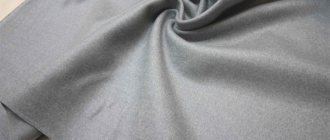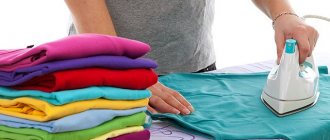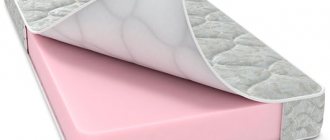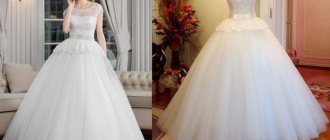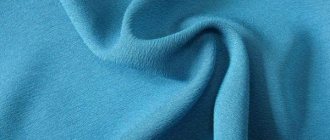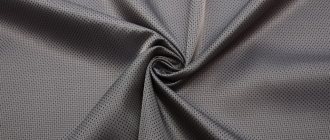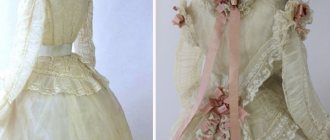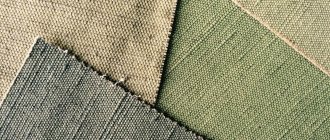General tips and rules
If the fabric is mixed, that is, it contains several types of raw materials, then you need to choose the most delicate one and care for it as if it were a fabric made entirely of these fibers. For example, the composition includes 55% silk, 40% wool and 5% elastane. The most delicate thread is silk, so we care for this fabric like silk. If you are in doubt about the issue of care, a win-win option for any fabric is modern dry cleaning. If the product or fabric is given advice from the manufacturer - only chemically pure, do not wash under any circumstances, otherwise the fabric/product may produce unexpected special effects in the form of shedding or deformation of the structure of the fabric or the entire product. Nowadays there are a lot of different types of fabrics, so sometimes even the most seemingly unpretentious fabric may be recommended for dry cleaning. To be sure, you can always experiment on a small test piece of fabric, wash it and iron it.
Care Tips
Fabrics made from synthetic fibers are easy to care for. They can be cleaned in a washing machine; they do not require complex care or many manipulations. But in order for the service life of the products to be as long as possible, it is important to follow some of the advice given by manufacturers.
- Although items made from synthetic materials can withstand different temperatures well, you should not use excessively hot water when washing. It is better that the temperature does not exceed 40 degrees.
- After washing, it is not advisable to use the auto spin cycle. It is better to remove excess liquid by hand.
- For washing, you should use washing powder or gel intended for this type of fabric.
- The use of bleach and other aggressive products containing chlorine is not advisable.
- Products made from polyester fiber do not wrinkle, so they do not require ironing. If necessary, use an iron, choosing the appropriate mode.
Having studied what polyester is, it should be noted that such fabrics are rated quite highly.
Products made from popular materials look very attractive, which increases the demand for such products. Things made from polyester synthetic fibers last a long time. They tolerate temperature changes and changes in weather conditions well. Pellets do not appear on them, which has a positive effect on the appearance of the product, unlike those consisting entirely of natural ingredients.
Adding polyester fibers to blended fabrics can improve existing properties and even correct weak points. The presence of polyester makes the fabric more durable, wear-resistant and wrinkle-resistant. Although synthetic fibers have great advantages, we should not forget about the disadvantages.
Ironing
Ironing is one of the most important and necessary steps in caring for fabric and products. With proper ironing or steaming, you can delay the next cleaning. For example, this applies to products made from suit wool and coats. Steaming in this case raises the pile (or micropile) and partially removes contaminants from the fabric structure, and cleaning occurs. If the fabric has a voluminous texture or volume (for example, knitted jersey), you need to iron it without pressure or even at a distance of 2-3 centimeters from the surface. This applies to any type of fabric. Always iron fabrics in one layer. A great way is to use a vertical steamer. Hang the product/fabric on a mannequin or hanger and use a steamer. If you steam a product at home, without special tailoring equipment (pads), and you need to steam hard-to-reach places (for example, the side under a sleeve, etc.) and small parts (for example, pocket flaps, places of relief darts, etc.), use a special heat-resistant glove. They are sold in hardware and sewing stores and are very convenient to use. If the fabric is embroidered with beads, sequins, beads, etc. - use a steamer. Use steam at a distance of several centimeters so that the folds on the base are straightened out, but the beads and sequins, especially plastic ones, do not melt. Yes, this can really happen) Another important note regarding embroidered fabrics - glass beads and seed beads can scratch the surface of the iron.
Life hack
How to iron so that no stripes remain? There are two ways, and here you can choose the one that is more convenient for you. The first is to use a Teflon attachment on the sole of the iron, the second is to use an iron - a piece of fabric, usually clean white calico or gauze, through which you will iron. When you use a vertical steamer, the appearance of lass is eliminated. When ironing synthetic knitted fabrics, use a special ironing mesh to avoid any laces remaining. It is sold in hardware and sewing stores.
Decatation
This is often done by a tailor if you are sewing to order. If you sew yourself, you need to prepare the fabric for cutting. In the process of decating, you need to do the same thing with the fabric before cutting that you will then do with the product. If the product will be washed, the fabric must be washed; if the product will be dry cleaned, the piece of fabric must be taken there. During the decating process, the fabric undergoes its first shrinkage and the color is fixed. Decating also removes warehouse dust from the fabric, which, even minimally, still gets into the structure of the fabric. As a result, you have in front of you a clean, ready-to-sew fabric that will no longer bring any unpleasant surprises)) Working with it is a pleasure! Sizing and cushioning materials and insulation, as well as some types of additional materials (trouser tape, bias tape, etc.) must also be decatified! Additional materials are usually simply ironed with steam. When decating the sizing material, it is important to steam the fabric so as not to disturb the adhesive layer. Hang the cut straight out in a damp place (for example, in the bathroom), pre-moisten it with a spray bottle. It is best to hang it above the bathtub with some warm water in it. Let the fabric hang like this for some time and soak in damp heat - an hour is enough for thin fabric, overnight - for thick duplerin, for example, collar. Then air dry the fabric.
Ironing principles
It is important to iron synthetics correctly so as not to damage the fabric with the iron - it can become irreparably deformed or completely melt. Some types of fabrics do not need ironing - just dry the clothes flat.
When ironing with an old type iron, the regulator is set to the first position, since overheating should not be allowed. On modern models, regulators allow you to accurately set the desired mode, while information on what temperature to iron at is indicated on the product label.
Caring for silk fabric
All silk fabrics absorb moisture equal to half their own weight. At the same time they dry very quickly. Skin moisture evaporates very quickly from the surface of the silk, but sweat stains may remain, which are recommended to be removed with alcohol. Natural silk fabric may fade greatly during normal washing. Silk is a light and thin fabric, so it can only be washed by hand in lukewarm water. Under no circumstances should you rub or twist a silk item with your hands. After washing, the silk product must be rinsed in cold water, adding a little vinegar in order to restore the brightness of the colors. After washing, the product is dried away from radiators and direct sunlight. Iron silk items while wet on the reverse side, without wetting, as water may leave stains.
Flax care
Linen fabric has a smooth surface and matte shine. Products made from linen get dirty a little, do not lint, absorb moisture well and dry quickly. Linen fabric is particularly durable. The noble properties of flax include its great creasing properties. Linen fabrics can be boiled. The washing temperature is selected depending on the finish of the fabric. Linen products can be washed in a washing machine at a temperature of 30 - 40 degrees. Colored fabric is washed at 60 degrees. Linen items may shrink after washing. Iron them with a well-heated iron with a humidifier.
How to care for fabrics
Today, there are a huge number of fabrics from which stylish and fashionable clothes are sewn. Materials may differ from each other both in composition and in their qualities. In order to preserve your favorite item for a long time, you need to properly care for it. It is important to note that all fabrics that are used in tailoring have their own care rules.
Some fabrics are of plant origin, are considered hypoallergenic, and have a fairly low price. It is from such natural materials that dresses for the summer are made. The most common types are:
– linen – this type of material is quite durable and reliable, has a smooth surface and a noble matte shine. It is important to note that when cutting flax, its edges crumble. Caring for this fabric is quite simple:
1. Wash at a temperature of +400 – 600C in a machine on a delicate cycle using powder without bleach.
2. You can’t dry things in a machine, it’s best to dry them naturally. This categoricalness is explained by the fact that the products can simply shrink.
3. You need to iron with a very hot iron using steam.
Popular natural fabrics include silk. Sewing a skirt , blouse, or dress from such material is a sign of excellent taste. The products look rich, sophisticated, elegant. It is very comfortable and convenient to wear, especially in hot weather, as it has a unique property - a cooling effect. It is not difficult to care for such fabric, the main thing is to know how to do it.
1. Silk items should only be washed by hand and only with mild detergents.
2. You need to dry it naturally, and in no case do you need to twist the clothes, just squeeze them out lightly, then place them in a towel, squeeze them out again and lay them out on a horizontal surface.
3. High-quality silk practically does not wrinkle, but if this is necessary, you need to iron the product when it is still wet. You need to remember that while ironing you should not spray the fabric with water, as marks may remain.
In addition to natural fabrics, other types of fabric are also used in modern clothing. Today, knitwear is popular - a knitted fabric, in the manufacture of which cotton fibers, synthetic or mixed, can be used. Products made from this fabric are quite comfortable, pleasant to the touch, and also have the properties of stretching and hugging the body, and when the item is removed, they return to their original shape. Caring for the fabric is quite simple, the main thing is to follow the rules
1. You can wash it by hand, without rubbing, or in a machine in a delicate washing mode.
2. You need to dry knitwear items in a straightened form; you do not need to wring it out too much first.
3. If you need to iron, then only at the temperature recommended on the label or on the advice of the studio where you were sewn a stylish product.
4. Pellets may form on the surface of the fabric; they must be carefully cut off with scissors.
How to care for fabrics
Cotton care
Cotton products are very durable, withstand high temperatures well, and are a very dense fabric. A special feature of cotton fabric is its excellent ability to absorb moisture. The disadvantages of cotton are its high wrinkleability and strong shrinkage when washed. Cotton takes a very long time to dry after washing. Cotton fabric can be washed in a washing machine at a temperature of 30 - 40 degrees. For washing white laundry, use universal detergents; for colored laundry, use mild detergents and products without bleach. A heavily shedding item should be washed only in cold water and dried in a well-stretched form immediately after rinsing. Add salt to the rinse water (1 tablespoon per 10 liters).
To determine whether a colored item is fading, wet the tip and wring it out in a white cloth. If there is a colored stain left on the cloth, wash the colored item separately from the others.
Cotton items can also be machine dried, but remember that this can cause them to shrink a lot. It is recommended to hang items with an enriched finish wet to dry. Iron cotton fabrics using an iron with a humidifier.
Washing instructions for 100% polyester
Many items of home textiles and clothing, bags and backpacks are made from 100% polyester. Depending on the method of processing the canvases, they may have different properties: resistance to pollution, chemical attack and water resistance. The general rule for all polyester fibers is to follow the washing regime.
Threads obtained from petroleum products are not resistant to high temperatures and some types of solvents. Care instructions are indicated on the product label. The first symbol of the marking indicates the maximum permissible water temperature and recommendations for types of washing: hand or machine.
At temperatures above 40 degrees, the polyester thread is deformed, and the product loses its shape, stretches, and forms creases. There is another unpleasant point: in hot water, the threads become yellow. It is especially important to take this into account when washing tulle curtains, which many housewives want to make dazzling white. However, aggressive bleaches and hot water have the opposite effect.
Items made from 100 percent polyester should be washed when soiled. The fabric is resistant to them and therefore does not require too frequent cleaning. If, for example, a blanket or dress made of PE acquires an unpleasant odor, but remains relatively clean, you can rinse the product in warm water with the addition of fabric softener.
General rules that every housewife should know before washing polyester items:
- must be sorted by color to avoid staining. Whites should be washed separately from colours;
- It is recommended to turn the clothes inside out;
- Do not use chlorine-containing products;
- water temperature cannot exceed 40 degrees;
- using conditioner will increase the durability of products and maintain rich color;
- With any washing method, you need to wring out polyester items carefully, exclusively in a gentle mode.
Washing does not harm polyester fibers. The recommendations outlined above are considered universal. Care details, if any, are indicated by the manufacturer on the product tag.
Machine washable
Several recommendations should be taken into account in order to know how to properly wash polyester in an automatic washing machine:
- you need to select one of the modes: “Delicate” or “Sport” with a speed in the range from 600 to 800 units/min.;
- Washing powder must first be dissolved. Choose gentle detergents, optimally use liquid solutions;
- Do not tumble dry.
The powder is poorly washed out of the fibers, so the products require the use of either special shampoos or particularly thorough rinsing. You should squeeze it manually so as not to damage the fabric structure. Knitted items are sensitive to intense twisting: they can be greatly stretched and deformed.
Handwash
The manual washing algorithm differs only in that the item should first be soaked in a washing solution for 25 - 30 minutes. Further, universal recommendations are used. There is no need to vigorously rub or squeeze the wet material.
After washing, you need to rinse the laundry well and use conditioner at the final stage. It is necessary to squeeze with light squeezing movements without twisting. Lightweight, small items can be shaken and hung on hangers to dry without spinning. Knitted sweaters and dresses should be dried on a horizontal surface.
Removing contaminants
Polyester is resistant to stains due to the special properties of polymer threads. Minor fresh stains can be easily washed off as usual with pre-soaking. In other cases, stain removers and folk tricks will help correct the situation.
Important! It is prohibited to use chlorine-containing solutions to remove stains. Aggressive reagents such as toluene, benzene and acetone dissolve fibers, so various types of solvents can simply ruin the item. PE fabrics are resistant to acids.
Potato starch will help remove dirt from the surface of synthetic fabric. They sprinkle it on the stain, and after a few minutes they remove it with a sponge. You can wipe the dirt with a peeled potato tuber.
A cotton pad soaked in vodka or medical alcohol will help get rid of greasy stains. Leave for 30 seconds, then wash as usual. Before using alcohol solutions, it is recommended to test the effect on a piece of fabric or on the reverse side of the product.
Extra class table salt can cope with dirt. Sprinkle it on the stain, leave it for a couple of minutes, after which the area is soaped, being careful not to damage the fabric. Borax powder and lemon juice are effective. They can be left on the contaminated area for 5 minutes.
Drying
Drying of polyester products is carried out according to the manufacturer's recommendations. They are indicated on the tag (label). A square with three vertical stripes is a symbol that means that you will need to hang the product without squeezing or twisting.
The fact that drying in a straightened form is necessary will be indicated by a square in which a circle is inscribed with a dot in the center. Such things should be placed on a wire rack above the bathtub or in a well-ventilated area, protected from direct sunlight.
In most cases, the best way to dry is this: after thoroughly rinsing, the item is rolled up to drain the water, and then hung on hangers over the bathtub. Due to the fact that the material dries quickly, there are no difficulties with drying.
Ironing
100% polyester and blended fabrics containing this fiber are wrinkle resistant. Therefore, in most cases ironing is not necessary.
Items made of polyester should be ironed if creases have formed during machine washing. It is important to follow the ironing regime. The sole temperature should be 100 degrees. The maximum allowed value is 110.
When ironing, it is recommended to use an ironing pad - a gauze cloth or thin cotton fabric between the soleplate of the iron and the polyester.
Caring for wool products
Wool fabric retains heat very well, gets dirty relatively little and does not wrinkle much. Sometimes, in order for wrinkles on clothes to be smoothed out, it is enough to hang them in the bathroom or sprinkle them with water. Wool items should only be washed by hand using mild wool detergents. When washing, a woolen product should not be rubbed or twisted. Wool does not like long soaking. The washed product is not wrung out, but gently blotted, wrapped in a terry towel. When drying, a wool product should not be hung up as it may become deformed. When wet, woolen items are laid out on a flat surface. Iron them through a damp cloth. It is recommended to dry clean high-quality wool products.
Features of care for textiles made from various types of fabrics
The variety of materials from which things for the home are made today requires housewives to have deep knowledge. Manufacturers have already developed general rules for caring for modern fabrics.
Summarized data is presented in the table:
| Type of fabric | Washing/cleaning | Spin/dry | Steaming/Ironing |
| Cotton materials (calico, poplin, percale, satin, flannel) | Temperature for undyed fabrics is 60 ºС, for materials with a pattern – 40 ºС, the use of powders, soaps, softeners and conditioners is allowed. | In automatic cabinets, high speed spinning, hot air supply, as well as normal, natural mode. | Iron surface temperature – 100-150 ºС, use of modern steam supply systems |
| Silk | Hand or automatic washing in the “delicate fabrics” mode at a temperature of 30 degrees, using special detergents (liquid, neutral) | In automatic mode, spinning is prohibited, drying with natural ventilation in a shaded room is recommended | Iron through a thin, dry fabric in the “silk” mode, or at minimum temperature, avoid getting moisture on the fabric |
| Wool fabrics | General mode at a temperature of 30 ºС, using neutral, liquid detergents, professional dry cleaning | Natural, without direct sunlight, use of specialized dryers | At low temperatures with steam supply |
| Universal synthetic fabrics (polyester, polyamide) | Normal, automatic at 40-60 ºС, using detergents | Automatic and natural drying | At low temperatures, without steam supply |
| Non-woven synthetic materials (fleece) | Manual or automatic, in “delicate fabrics” mode, at a temperature of 30 degrees, using mild detergents | Spin mode no more than 1000 rpm, natural drying without the use of hot air | At low temperatures |
| Tapestry | In warm (up to 30 ºС) water, using special detergents, some types of tapestry are prohibited from washing at home, cleaning using hydrocarbons, monofluorotrichloromethane is recommended, and the use of bleaches is prohibited | Automatic drying and spinning are not recommended | Iron at temperatures up to 150 ºС |
| Terry products | Mode 30-40 ºС (for some products 60 ºС) degrees, use of liquid detergents and conditioners | Do not squeeze or rub, because... Terry loops may break, gently spin and dry in the open air | The use of irons and steamers is not recommended; it is better to dry terry products in a vertical position or on special stands |
It should be noted that each type of fabric includes many varieties. For example, woolen home textiles are very widely represented.
| Type of wool fabric | Velours | Jacquard | Plush | Felt | Tweed |
| Wash | Not higher than 30 ºС, “delicate” mode, water-based cleaning products | 25-30 ºС, it is not recommended to use weakly alkaline products (ordinary powder or soap), bleaching is not allowed | Washing at home is not recommended, it is better to use dry cleaning services | in water at a temperature not exceeding 30 ºС, with neutral agents, with softening additives, without spinning | In cool water, up to 28 ºС, without soap or powder, the use of special products is allowed |
Viscose care
Viscose fiber, when processed differently, can resemble silk, cotton or even woolen fabric in its luster and density. Viscose fiber is even used to produce the thickening threads characteristic of flax. Products made from viscose absorb moisture well, but lose strength when wet. Therefore, they require especially careful washing. Products made from viscose are washed using mild detergents by hand or in a washing machine at a temperature of 30-40 degrees. It is not recommended to twist the product, much less squeeze it in a centrifuge. Iron the viscose with an iron with a humidifier at a temperature of 150 degrees (the thermostat position is “silk”).
Recommendations for caring for popular curtain fabrics
Cotton (satin, chintz)
Cotton fabrics withstand hot water well, so they can be washed at temperatures up to 40 °C. For white curtains, use detergent with bleach; for printed textiles, use washing gel for colored fabrics.
Natural cotton fabrics can shrink, so you need to wring them carefully, at moderate speeds, and dry them by hanging them or laying them out on the dryer. Iron cotton items while they are damp.
Curtains made of cotton fabrics
Linen, matting
This material is one of the most unpretentious. But since linen is prone to shrinkage, and curtains are not something that gets excessively dirty, 40 degrees when machine washed will be quite enough.
Colored and unbleached linen is considered more delicate, so it can only be washed with mild detergents. To prevent the fabric from shrinking during the drying process, the wrung-out product must be unrolled and shaken vigorously, and only then dried.
Iron linen curtains at maximum temperature, moisturizing the fabric.
Linen curtains
Velvet (velor, microvelvet, microvelvet)
If you have curtains made of natural velvet, do not try to wash them yourself - you will ruin the expensive fabric. There is only one option - dry cleaning.
Artificial fabrics with pile are not so whimsical, but still require careful handling. Before washing, they need to be carefully rolled up with the pile inward and placed in a bag. The water should not be hotter than 30 °C, set the mode to delicate, without spinning. After washing, lightly wring out the fabrics with your hands and dry them straight. If the curtains are trimmed with fringe, it needs to be torn off and then sewn back on.
To iron velvet fabrics, it is best to use a steam generator, which will smooth out wrinkles but not wrinkle the pile. You can iron velvet only from the lining side and in the direction of the pile.
Curtains made of velvet, micro-velvet, velor
Software, microsoft
The soft has a velvety texture with short silky bristles and a smooth matte back. This is one of the most practical fabrics for sewing curtains. It does not deform during use, does not fade, does not fade, and dries quickly after washing.
For products made from software and microsoftware, a delicate wash in a machine at 30 °C, with a gentle detergent and without spinning, is acceptable. When straightened, the fabric dries within an hour and does not form creases, so it does not need to be ironed. But if ironing is necessary, the iron temperature should not exceed 110 °C (synthetic mode).
Curtains made from software and microsoft
Silk (satin)
It is recommended to wash silk and satin curtains exclusively by hand in slightly warm water (not higher than 30 °C) with mild soap. They cannot be rubbed, wrung out, twisting the fabric, or dried in a centrifuge. It is best to let the canvas drain and dry naturally. Iron silk fabrics from the inside out at a temperature of 60–80 °C. Do not wet the fabric; stains may remain.
Satin curtains
Jacquard
Jacquard is a fabric with a special weave of fibers, thanks to which it does not deform, does not stretch, and does not fade. But the material does not like washing, so to clean such curtains it is better to contact a specialist.
Jacquard curtains
Viscose
Viscose fibers lose strength when wet, so dry cleaning is preferable for such textiles. If you decide to wash viscose curtains at home, you need to do it carefully - manually or on a delicate cycle in a machine. They need to be wrung out carefully, without twisting the fabric, and dried in a straightened state. Iron viscose in silk mode.
Decorative viscose curtains
Organza
Organza consists of silk and viscose fibers, which determine the washing mode of this material. Place the delicate fabric in a bag before putting it into the drum. Wash curtains in a delicate cycle with soft gel and spin at the lowest speed. Organza can be immediately hung on the windows, where it will dry and straighten. If you want to iron, set the temperature as for silk or synthetics.
Organza curtains
Polyester
Curtain fabrics made of 100% polyester can be machine washed at 40°C without spinning or spinning at low speed (up to 400). The wet product must be straightened and dried in this form. Iron the polyester with an iron heated to 150 °C, moistening the fabric.
Polyester curtains
Blackout
If your blackout curtains have a white acrylic lining or a decorative metallic layer, it is better to dry clean them or hand wash them with a delicate detergent at a temperature of up to 40 ° C.
Other light-proof fabrics can be washed in an automatic machine in the same mode and with a low spin cycle. To prevent the fabric from shrinking, it is recommended to hang the linen on the window immediately after washing (for hand washing, as soon as the water has drained).
Blackout curtains
